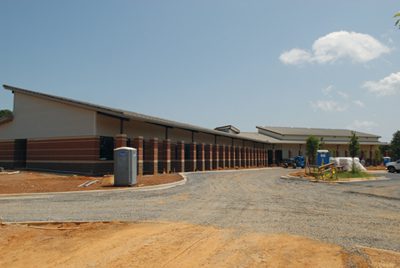by Lauralee Wilcox McCool
The hot trend in construction these days is building “green” and the Greenbrier School District is setting the standard with the addition of its third elementary school.
Designed for kindergarten through fourth grade, Wooster Elementary will open this fall to approximately 420 students, according to Lenett Thrasher, school principal. Fifth grade students will attend the elementary school for one year while a new intermediate school is built.
 Randy Talculcuit of the firm Jackson, Brown, King Architects in Little Rock, lead architect for the project, said the green design of the building will save the district money in operating costs.
Randy Talculcuit of the firm Jackson, Brown, King Architects in Little Rock, lead architect for the project, said the green design of the building will save the district money in operating costs.
The firm is seeking LEED (Leadership in Energy and Environment Design) certification through the U.S. Green Building Council. According to the council’s website, “LEED emphasizes state-of-the-art strategies in five areas: sustainable site development, water savings, energy efficiency, materials and resources selection, and indoor environmental quality.”
The most striking exterior feature of the building is its use and positioning of windows to utilize the sun as a light source but minimize its impact on heating. “The whole building is oriented in a way to use natural light and save money,” Talculcuit said.
The school features large northern windows to capture sunlight, while deep overhangs on the south side deflect “the intense light that beams in from the south and west,” Talculcuit said. As a result, the school gets no direct light from the east or the west which helps keep the cost of cooling the building at a minimum. Plus, the windows have different colored tints according to their position with the solstice and the overhangs.
Talculcuit and Thrasher highlighted several features of the high-efficiency building:
– Sensors above the windows monitor the amount of sunlight coming in and automatically adjust the amount of electricity needed to sufficiently illuminate the rooms.
– Motion sensors in the ceiling automatically shut the lighting off when no movement is detected.
– Carbon dioxide sensors control the amount of fresh air that enters the building. As the number of people inside the building increases, more fresh air flows in.
– Tall ceilings in the hallways and classrooms provide a feeling of openness and allow for greater acoustical performance.
– Stained concrete floors can be dry mopped allowing fewer chemicals to be used in cleaning. There are no vinyl or tile floors in the building.
Major furnishings will be certified by the GreenGuard Environmental Institute, meaning the products have been tested to ensure that their chemical and particle emissions meet acceptable indoor air quality pollutant guidelines and standards.
The landscaping and outside areas are also being constructed with an eye for the environment. Parents and visitors will enter the building through a covered outdoor classroom area to provide even more opportunities for students to learn in a natural setting.
The courtyard area leading to the playground allows grass to grow through a concrete design in certain areas. Trees and plants in planters provide shade during outdoor play times.
Plants and materials used in the landscape design require very little maintenance and will make it appear as if the building has always been there.
Thrasher described how building “green” ties in with the pedagogy of the students.
“All the ‘green’ features of this building are designed to provide the best natural learning environment possible for students,” she said. “However, as a parent, I believe the greatest asset is the opportunity for our students to learn how to better care for our planet.”
Students will help plant and maintain a vegetable garden. The district hopes to add a compost area “so that the students can learn to take what is left over from some of our meals to help produce more food,” Thrasher said.
“Our students will learn about the importance of recycling so that usable materials are not put into our landfills. We will begin by recycling paper, plastic, aluminum, glass and corrugated cardboard. However, we plan to expand this to newspapers, magazines, leather tennis shoes and many more items.
“There will be many hands-on learning experiences for our students. The overall goal is for them to learn to give more back to our planet than they take away.”

